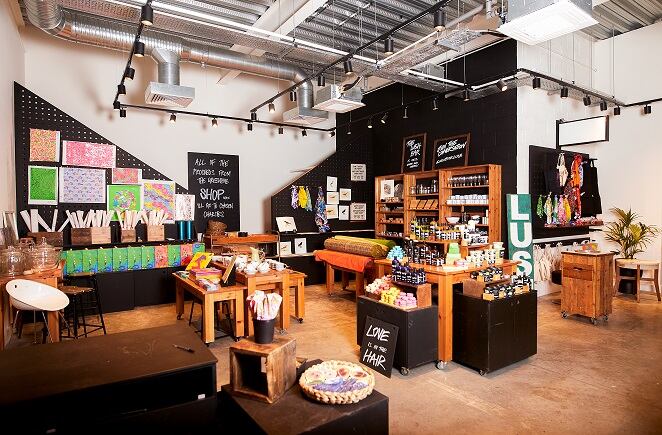Lush first opened an on-site Green Hub in 2015 to find new ways to reuse, repurpose and recycle by-products from its cosmetics production, but quickly saw a need for a larger in-house facility completely dedicated to waste management.
The company decided to invest £2.3m to relocate to and refit a new 40,000 sq ft premises in Fleets Corner Business Park, Poole.
Two years later, after a lot of hard work, the new Green Hub is up and running and open to the public. The new building is three times the size of its previous location and has improved its capabilities to reuse, repurpose, repair and recycle materials from across the whole business.
According to Eloise Flinter, Business Development Manager for The Green Hub, the new facility serves two purposes: The first was to increase capacity for recycling. “The new machinery allows us to process 10 times more waste,” she explained. “We have gone from recycling 2.5 tonnes of waste to 20 tonnes – the weight of a London bus. This increases local recycling capacity and new infrastructure for a circular economy in our area.”
The second purpose was to open the facility up to the public to reach the local and global communities, such as schools, local groups and like-minded businesses. “By opening up to the public and working with the community, people can physically see the circular economy and it can have more impact,” explained Flint.
Investing in racking and repurposing granulators
To reduce transport emissions, the move involved relocating six different departments under one new roof – from electrical engineers in the repairs department to carpenters in the woodwork department, and even a laundry department where Lush washes the towels and linen used in its spas.
The activities carried out at the Green Hub include: granulating plastic as part of the brand’s ‘Bring it Back’ customer recycling scheme; treating wastewater from its manufacturing and laundry processes; repairing machinery so it doesn’t need to buy new ones; and donating funds to charities and grassroots groups across the UK from selling surplus products.
Flinter revealed that Lush continued to repurpose its waste while it relocated the Green Hub, which was no easy task.
“While we repurposed our plastic granulators, we had to store all of our packaging returns throughout this time,” she said (as Lush encourages customers to bring their used packs back to the stores to receive 50 pence per item). “Now the granulator is back on, it’s been running round the clock to process all of this accumulated packaging.”
During this period, the company invested £55k in racking to store the packaging that needed to be reprocessed. “We will still use the racking,” says Flinter. “It currently has everything from Christmas trees to baths on it – from when we have done events or store remodels. All ready to be reclaimed and reused again.”
Repairing, reusing and recycling
Along with looking after the company’s 15+ manufacturing buildings and maintaining and repairing over 300 pieces of machinery, Lush’s repairs team is on-hand to fix anything and everything.
“It’s great that we are all together in the hub as it prevents delays – if a machine breaks now we can get it fixed straight away,” says Flinter. “The repairs team is very busy, as we encourage repairs across the board. They’ve repaired everything from broken kettles to an electric scooter for our teams.”
The company also has an in-house shop, which Flinter dubs: “a trash-to-treasure store.” It sells all kinds of items that are left over from the business. For example, teapots that were used in spa treatments were sent back to the Green Hub shop and sold for a small sum to raise funds for grassroots charities.
“We also reuse and resell our gift packaging,” said Flinter. “Last year we donated over 100,000 products to local charities and produced gift packaging for schools’ arts and crafts projects. We look at every material we use and see where else it can be reused or resold to raise funds for charities.”
Future plans: a close-looped water system
Now that the Green Hub is running at its full capacity, its next goal is to close-loop its water system to process 500 tonnes of dirty water each year. “Our water waste system DAF unit can clean dirty water from our manufacturing systems, then we can close-loop it and reuse it in the laundry facility and washing,” explained Flinter. “Before we had to transport tonnes of water to be transported off-site. Now we will be able to do that in-house, too.”
Lush has now opened the Green Hub to the public with a schedule of events, workshops and community engagement opportunities designed to facilitate environmental-focused education.
Flinter is excited to see the effects of this, as she makes it clear that the success of the Green Hub relies on collaboration between Lush and its customers, as well as the wider community.
“This collaboration is key for the circular economy to work,” she concludes. “Where we can come together and innovate with suppliers, customers, other businesses, schools, etc. this is the key to making it work, so we can ensure that we’re ‘Leaving the world Lusher than we found it’ – as we like to say here.”


